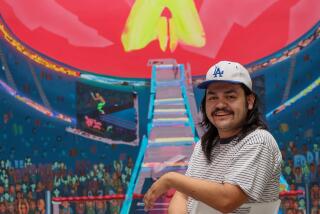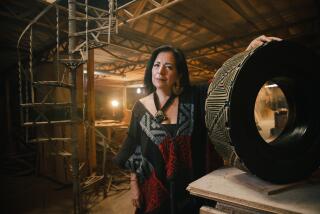The mess and playfulness of relationships run through Carmen Argote’s ICA LA show
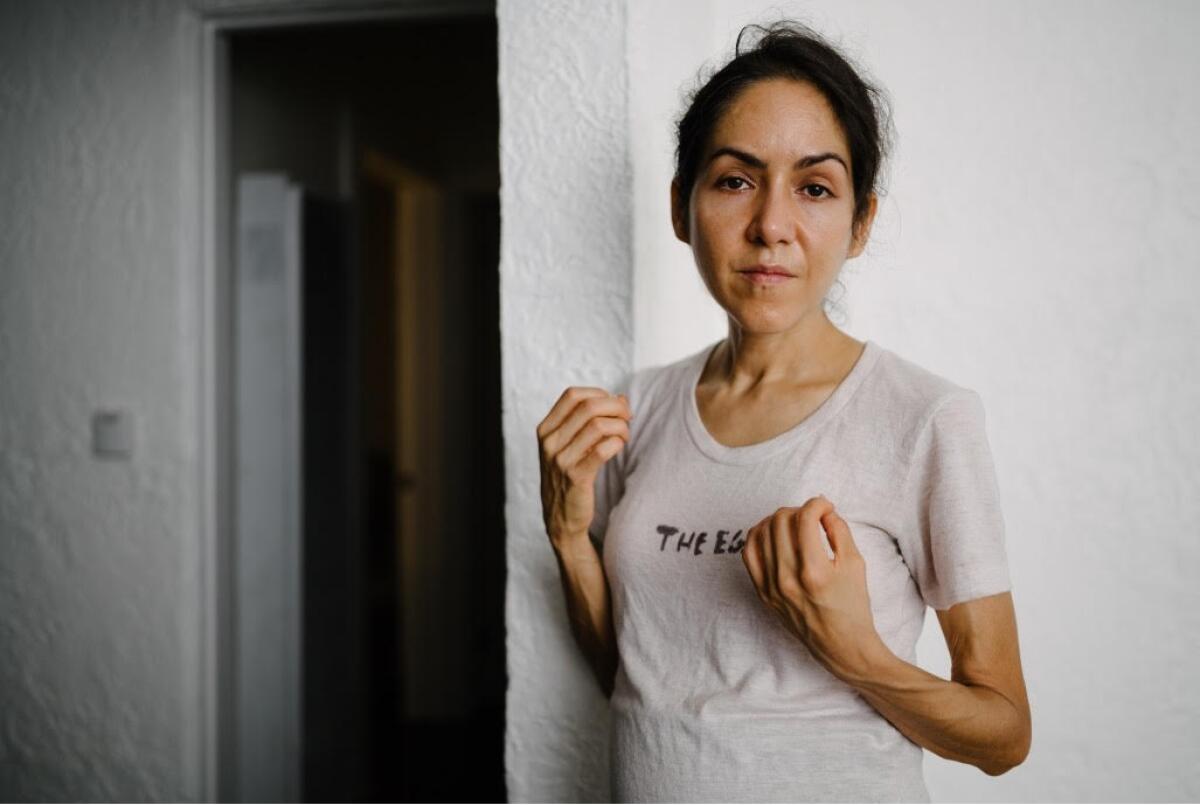
- Share via
In her 2018 book “Mothers: An Essay on Love and Cruelty,” Jacqueline Rose describes the process of bonding with her adopted daughter as “going through an inverse pregnancy, moving backwards in time, letting her in. Or rather, it felt, her claiming her place as she crawled inside my body and into my blood-stream.”
“Mothers” is at the top of a stack of books selected and rope-bound by art historian Mary McGuire, one of five collaborators in artist Carmen Argote’s exhibition at the Institute of Contemporary Art, Los Angeles downtown. Piles of them are situated toward the center of the white space.
Above the books hangs a swath of raw linen adorned with oak galls — scabs shed from the trees Argote passes on routine walks in her neighborhood of Boyle Heights. She sewed the material in the shape of two touching ♀ female symbols, with the fabric’s ends roughly braided and knotted at the bottom. “The mind, the heart, the stomach — the integration of the self. That’s where the braid converses,” Argote says. “I think of braiding as an integration to make something stronger.”
Textiles stand in for both mother and daughter — and the weaving of their relationship — throughout the Los Angeles artist’s installation “Carmen Argote: I won’t abandon you, I see you, we are safe,” which focuses on familial bonds. Specifically, the exhibition ruminates on the connective tissue among generations and explores the inner emotional realms: Argote’s “comforting objects,” brightly painted baby-size bundles of textile and organic materials, gathered in close physical and emotional proximity (corn husks, palm fronds, her clothes and house mats), rest on crib-size plinths on the floor or are propped up against the wall throughout the space.
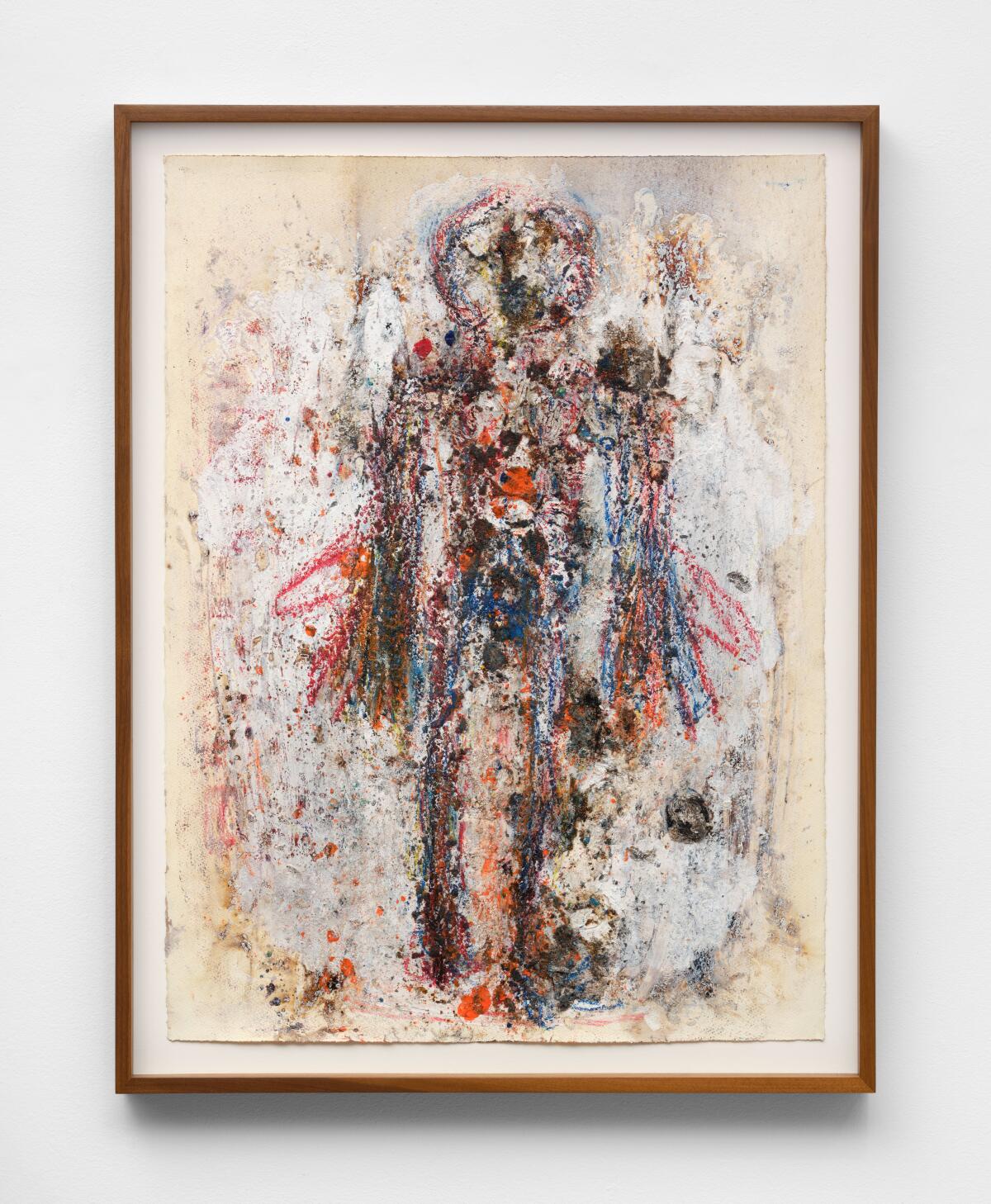
“Language can re-mother; it can give acceptance and acknowledgment. The title of the show — I use those phrases to attend to my own inner child parts, in parts work and internal family systems model therapy,” she says while cradling “Communication Tools,” a comforting object made of a heaving bouquet of oak galls, like a sleeping infant in her arms.
“Making the work is so relational, and a little uncomfortable, because I’m usually working on my own,” she says.
But bringing in collaborators, including McGuire; artist Cedric Tai; Argote’s gallerist, Commonwealth and Council’s Young Chung; REDCAT curator Daniela Lieja Quintanar; and her mother, artist and educator Carmen Vargas, “has been a re-mothering and lets me actually be present.”
The exhibition expands with Argote’s near-daily visits to tend to the space, where she jots down notes and musings with colored pencil on the walls between works. Argote motions to the fresh eggs lined up in a row on the ground, below the works on the walls above. On each, she’s written the name of the hen that produced the egg. Her chickens are named after well-known artists, including Lee Lozano, Noah Purifoy and Bruce Conner.
“Tending to the show also means having conversations with people, making work here, inhabiting, sharing the notes on the wall as part of the progress,” Argote says.
Reading Carl Jung’s theory of individuation, the development of self-realization, led her to see her seven chickens as one continuous being, always in communication with wild birds. Past parts of Argote’s practice were further informed by reading texts by thinkers Octavia Butler, Clarissa Pinkola Estés and Angela Garbes.
A few weeks earlier, I had seen Argote perform with Vargas in the installation. Mother and daughter enacted a meditative, loose exchange, taking turns carefully tying and untying each other for nearly two hours with the jute rope that is traditionally used in their family’s region of Guadalajara. The performance ended with Vargas dressing Argote in a traditional jute garment she’d woven and playing a singing bowl for a brief sound bath.
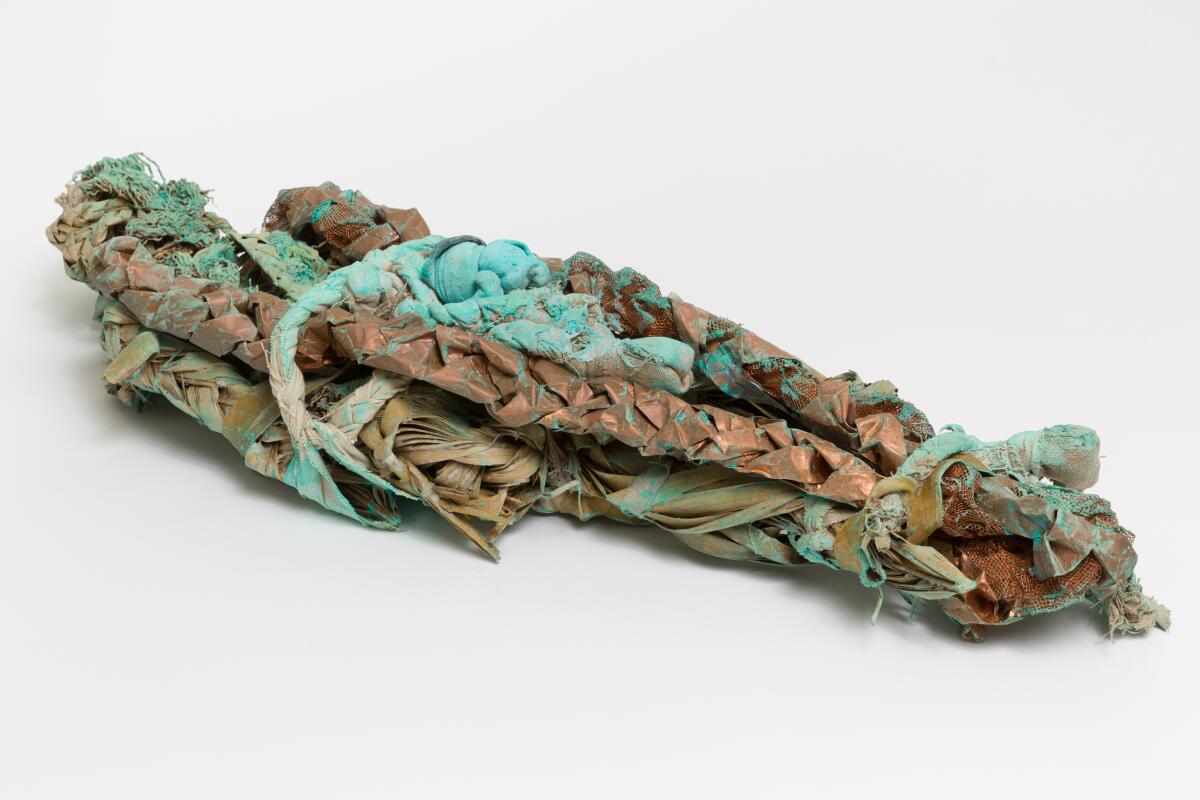
“I feel very close to her when we are binding,” Vargas says later of this ritual. The techniques are gestures that bind mother to daughter, partner to partner, and they “can be very simple — just wrapping your hands and communicating with the rope,” Vargas adds. “It took us to a place when [Argote] was a little girl and I was making a dress on her.”
Born in Guadalajara, Vargas has been in Los Angeles for the last four decades and now leads arts workshops at MOLAA, the Museum of Latin America Art, in Long Beach. Trips back to Mexico have taught her about ethnography and indigenous lineage, which has led to a rich exchange of ideas between mother and daughter, as well as bodies of work that keep these creative traditions alive.
In addition to the jute garments Vargas wove to clothe Argote in for the performance, the show also includes a more straightforward painting, “Pain Body,” made in what Argote calls “ancestral” oil paint. She has made textured collages of small bodies haloed in notes revealing their innermost thoughts outright and made of living components, including “let the child speak, you are not late, how thin are the walls between,” and “Ripe Child (a cosmic one),” drawn with cochineal, a striking red pigment made from ground and crushed insects native to Mexico.
When ICA LA senior curator Amanda Sroka, who organized “I won’t abandon you,” first visited Argote’s home studio, she says she saw “a body of work that so immediately connected to what it means to be human, with all its messiness, discomfort, shame, fantasy, healing, and play.”
“It’s interesting to see Carmen being here every day, playing with the social contract of the museum experience,” she adds. “Ordinarily, you would expect to look at an artwork, read the wall label and choose to either engage further or walk away, but in this instance, the presence of the artist changes that.”
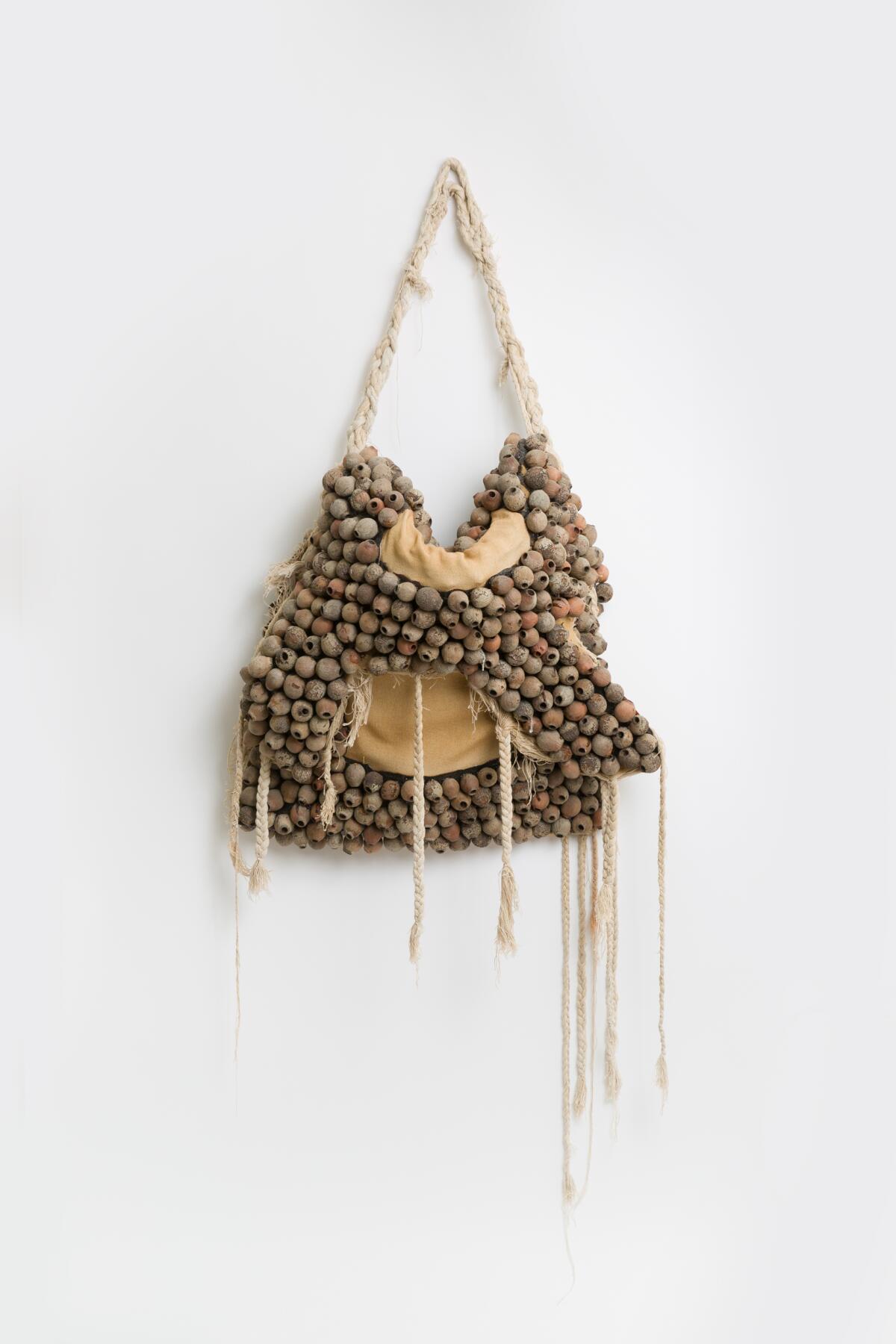
Photo: Ian Byers-Gamber)
Other works in this show, all of which were made over the last several years, include a selection from her “Gynecological Fantasy,” a series of bold, spare line drawings of figures, together and alone, limbs and torsos entangled, done in thick, coagulated oak gall ink, mostly monochromatic, on plain paper or linen; “urine maps,” abstract drawings made from messy material, including the artist’s own matter and iron, mixed up on yellowed paper; the “Protector” series, which features levitating small characters. These are drawn using a medium that combines “gross but beautiful” overripe figs she found splattered on sidewalks, then pressed with crayon, iron powder and salt. Strawberry syrup and banana skin preserved in gesso offer bright, sticky-sweet contrast in some shadows.
Circling these visual and process-based connections is a form of healing for Argote.
“I’d always made things with my mom, and generationally, for the women in my family, making and creating has been a way to hold onto self amid sometimes really difficult conditions,” Argote says. “It’s held some kind of knowing. It protects our soft spot.”
‘Carmen Argote: I won’t abandon you, I see you, we are safe’
Where: Institute of Contemporary Art, Los Angeles, 1717 E. 7th St.
When: Noon to 6 p.m. Wednesday, noon to 7 p.m. Thursday, noon to 6 p.m. Friday 11 a.m. to 6 p.m. Saturday and Sunday. Closed Monday and Tuesday. Through Sept. 10
Info: (213) 928-0833, [email protected]
More to Read
The biggest entertainment stories
Get our big stories about Hollywood, film, television, music, arts, culture and more right in your inbox as soon as they publish.
You may occasionally receive promotional content from the Los Angeles Times.

